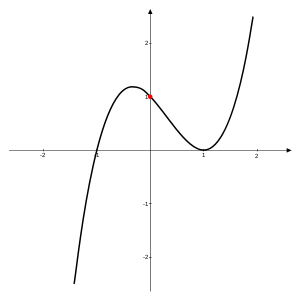y-intercept
In analytic geometry, using the common convention that the horizontal axis represents a variable x and the vertical axis represents a variable y, a y-intercept or vertical intercept is a point where the graph of a function or relation intersects the y-axis of the coordinate system.[1] As such, these points satisfy x = 0.

Using equations
If the curve in question is given as the y-coordinate of the y-intercept is found by calculating Functions which are undefined at x = 0 have no y-intercept.
If the function is linear and is expressed in slope-intercept form as the constant term is the y-coordinate of the y-intercept.[2]
Multiple y-intercepts
Some 2-dimensional mathematical relationships such as circles, ellipses, and hyperbolas can have more than one y-intercept. Because functions associate x values to no more than one y value as part of their definition, they can have at most one y-intercept.
x-intercepts
Analogously, an x-intercept is a point where the graph of a function or relation intersects with the x-axis. As such, these points satisfy y=0. The zeros, or roots, of such a function or relation are the x-coordinates of these x-intercepts.[3]
Unlike y-intercepts, functions of the form y = f(x) may contain multiple x-intercepts. The x-intercepts of functions, if any exist, are often more difficult to locate than the y-intercept, as finding the y intercept involves simply evaluating the function at x=0.
In higher dimensions
The notion may be extended for 3-dimensional space and higher dimensions, as well as for other coordinate axes, possibly with other names. For example, one may speak of the I-intercept of the current–voltage characteristic of, say, a diode. (In electrical engineering, I is the symbol used for electric current.)
See also
- Regression intercept
References
- Weisstein, Eric W. "y-Intercept". MathWorld--A Wolfram Web Resource. Retrieved 2010-09-22.
- Stapel, Elizabeth. "x- and y-Intercepts." Purplemath. Available from http://www.purplemath.com/modules/intrcept.htm.
- Weisstein, Eric W. "Root". MathWorld--A Wolfram Web Resource. Retrieved 2010-09-22.